Perspectives
The Deloitte Research Monthly Outlook and Perspectives
Issue 86
Published date: 13 November 2023
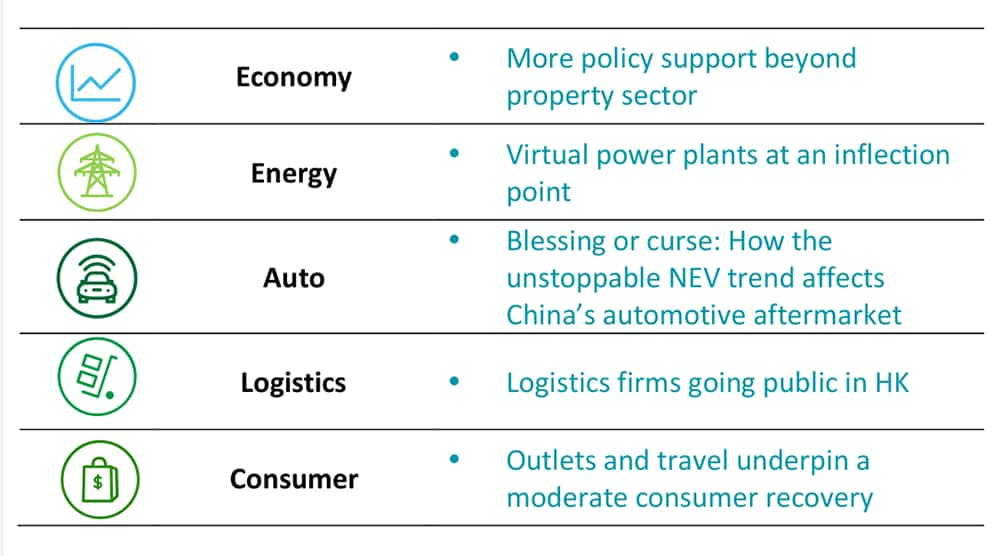
Economy
More policy support beyond property sector
The current state of the Chinese economy can be classified as a stalled recovery, but it is increasingly showing visible signs of stabilization. Q3 GDP growth of 4.9% yoy has effectively removed uncertainties regarding the 2023 growth target of around 5%, but there are several key questions to consider: 1) Will this stabilization last, particularly in areas like exports and retail sales, and prevent a potential 'double-dip' recession? 2) Will issues in the property sector continue to significantly impact consumption in 2024? 3) Will the external economic environment provide policymakers with more flexibility in 2024?
Assuming Q4 growth reaches 4.5%, which appears to be a distinct possibility, GDP growth for 2023 will reach 5%. Export growth, which experienced contractions for most of the year, showed a much narrower deceleration in September of -6.2% yoy. This underscores China’s manufacturing strength, particularly in the electric vehicle and electronics sectors. Retail sales, serving as a proxy for consumption, performed well in Q3, with a 5.5% yoy increase in September. Activities related to travel, dining, and entertainment also continue to thrive, with the catering industry's income growing by 13.8% yoy in September. However, the housing sector remains in a slump. In the first nine months of 2023, the sales area of commercial properties and property investments decreased by 7.5% yoy and 9.1% yoy, respectively. The planned building area of sold land in 100 large and medium-sized cities fell by more than 30% yoy in Q3, and price indexes of newly built commercial properties and pre-owned residences in 70 cities slightly decreased by 0.6% and 3.2% yoy in September. We believe that the broader residential housing market is unlikely to experience a significant price correction due to low consumer leverage and pent-up demand, although certain second-tier and third-tier cities with less favorable demographic profiles could face a prolonged downturn.
From a policy perspective, stabilizing the residential housing market remains a paramount goal, not due to systemic risk – which we have ruled out – but rather because most consumers are financially dependent on property, which comprises on roughly 70% of their overall wealth. This policy support for the property market has become more urgent as evidenced by the severe financial distress of Vanke, a major property developer, whose surging USD bond yields, rising from 15% to nearly 50% by the end of October, indicate a high risk of bankruptcy. The policy responses we have been advocating for all along include: 1) unlocking demand (both pent-up and trading-up) by removing restrictions on home buying in first-tier cities, which has been significantly loosened in Guangzhou; 2) reducing short-term interest rates; and 3) extending property rights of homes, for example, to 100 years (currently sold on a 70-year lease). We anticipate more support measures on the horizon, but there is a risk that a stabilizing economy may lead to complacency. In fact, one lesson from Japan's experience was its reluctance to acknowledge losses on banks' balance sheets and its cautious approach to restructuring corporate debt. In this context, both fiscal and monetary policies could be more assertive by increasing fiscal transfers to local governments and cutting interest rates.
Figure: Resilient retail sales, stabilizing exports & struggling housing sector
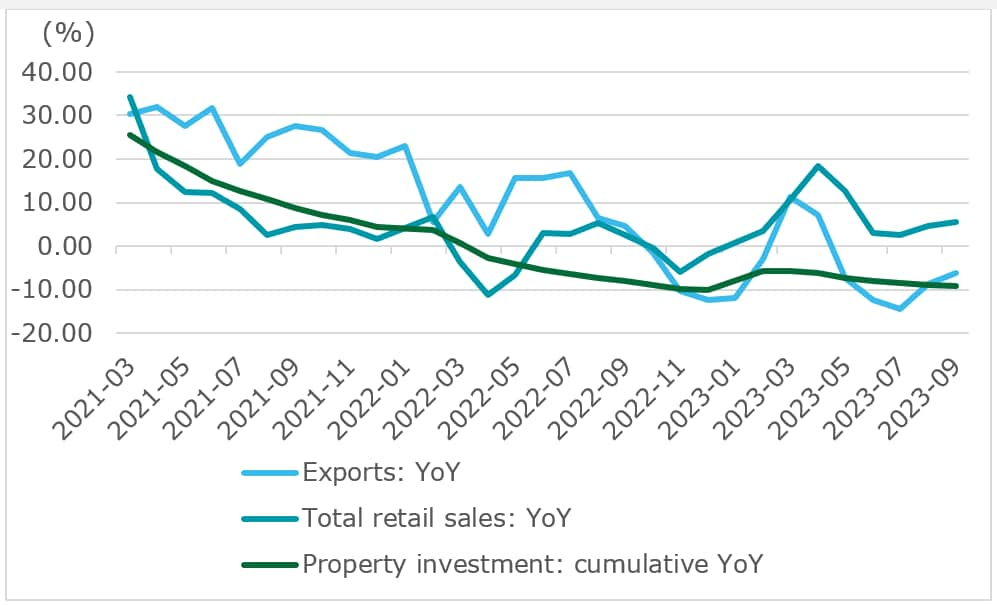 Source: Wind
Source: Wind
External factors do indeed influence the policy mix. China has maintained a loose monetary policy in contrast to the widespread tightening by most central banks, particularly the Fed, which left the Fed Fund Rates unchanged in its recent FOMC meeting. The Fed's decision provided some relief to shaken fixed-income markets, which have been rattled by the strength of the US economy, expansive fiscal policies, and elevated inflation expectations driven by instability in the Middle East. It is still too early to declare the Fed's success in taming inflation, but it is important to note that China does not face inflationary pressure. The main challenge instead is 'insufficient demand,' a concern repeatedly cited by policymakers. Therefore, regardless of the interest rate outlook in the US, reflation remains China's top priority.
In contrast to the situation in 2008, today's global economy grapples with a proliferation of industrial policies driven by populism and supply-chain reconfiguration. With the extraordinary fiscal expansion in many countries following the Covid-19 pandemic, fiscal risks are more significant today, as emphasized during this year's IMF-World Bank annual meeting. This implies that China’s flood-style stimulus from late 2008 should be avoided, necessitating a more calibrated fiscal support approach.
How can investor confidence, which has been shaken due to perceptions that economic growth is no longer China’s primary policy objective, be reignited without resorting to an overwhelming stimulus? Once again, we view fiscal support for the housing sector as critical. In practical terms, removing demand restrictions in Beijing or Shanghai would effectively bridge the gap between pent-up and trade-up demand, restoring the wealth effect and extending it to second-tier and third-tier cities.
Aside from reflationary measures, reinforcing China's commitment to an open-door policy will rekindle enthusiasm among entrepreneurs. Such a commitment also hinges on the intricate interplay of geopolitics, further complicated by domestic politics, including the 2024 US election potentially limiting the Biden administration's ability to pursue mutually beneficial policies such as tariff removal. In the meantime, both China and the US have taken tangible steps to create a more conducive environment for the Xi-Biden meeting at the APEC summit in San Francisco on November 17. For instance, a substantial US delegation attended the sixth China International Import Expo (CIIE) that kicked off in Shanghai earlier this month. Notably, meetings between Chinese leaders and the CEOs of Apple in late October and Micron Technology in early November are significant because both sides appear to be focused on risk reduction rather than decoupling. It is still early to speculate on concrete results from the leaders' upcoming meeting at the APEC summit, but all indications point to improved communication at the highest level and increased people-to-people exchanges, such as streamlined visa processes and more direct flights. A targeted reduction of tariffs would help rebuild trust, even though policymakers may find it difficult to draw a direct link between reduced protectionism and lower inflation for most US voters. In short, eased tensions between China and the US and peaking interest rates in the US will bode well for China in 2024.
Energy
Virtual power plants at an inflection point
On September 18, the National Development and Reform Commission (NDRC) and National Energy Administration jointly released new rules for a nation-wide electricity spot market, signalling that a national electricity spot market will be developed. The inclusion of virtual power plants (VPP) in the spot market indicates that they have reached an inflection point and from hereon we will see them develop at a much faster pace.
Highlights of new rules
The new rules draw on the experience of various regional pilot operations and provide guidance on the key issues such as market players, pricing mechanisms, settlement mechanisms, and market integration for establishing spot markets. Each region may then localize implementation based on its own market dynamics.
Figure: Highlights of China’s spot market basic rules (trial)
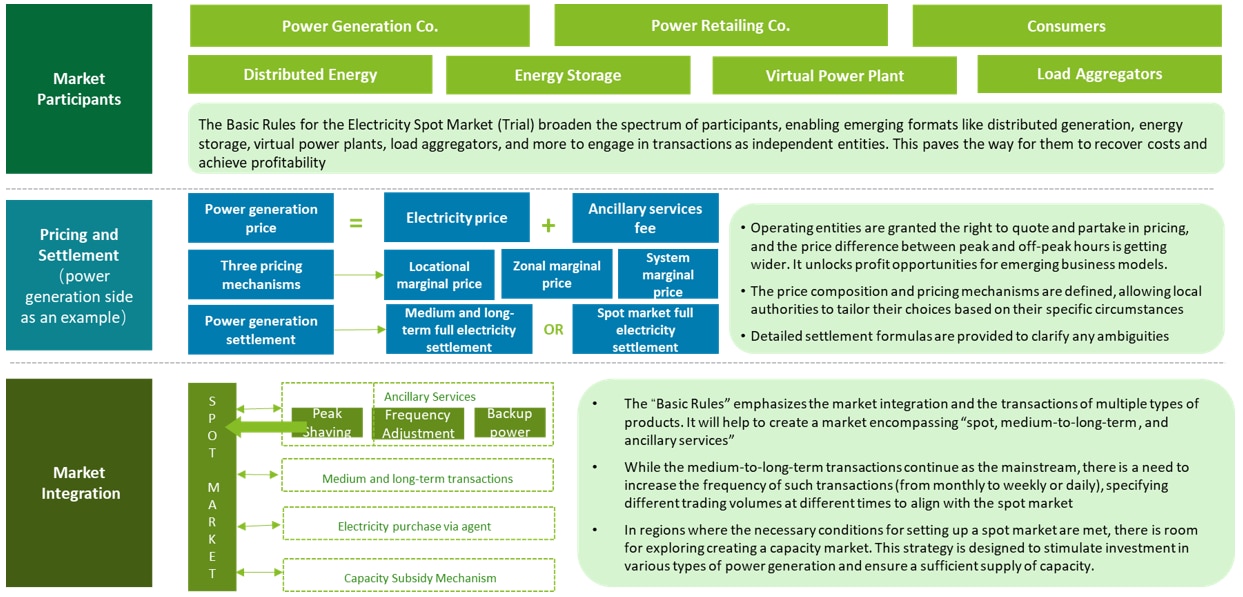
Source: Deloitte China
Spot market and VPP collaborate to balance electricity supply and demand
The electricity market is one of the key components in China’s new power system. On the supply side, the new power system draws on larger proportion of renewable energy and a wider net of distributed energy resources, leading to increased complexity and volatility in power generation. On the other hand, increased electricity consumption from households, EVs, and data centers leads to greater randomness and volatility in demand, making it more challenging to forecast and balance power supply and demand in real time.
The core function of the electricity spot market is to create a pricing system that is based on real-time supply and demand fluctuations and to guide electricity allocation through pricing. Imagine a scenario where on a cold, windy night, people turn on electric heaters causing a sudden surge in electricity demand that exceeds the planned supply capacity of the power company, resulting in a power shortage. The grid company quotes the electricity amount needed and offers a higher price for power at the local trading center. A platform that integrates distributed energy sources, energy storage facilities, and EV charging poles from different locations quickly responds to the surge in demand. By accurately calculating the power generation potential and electricity demand under its management, this platform provides the electricity to the grid——increasing electricity output from distributed wind projects, enabling the EV-charging residents to sell excess electricity back to the grid instead, and utilizing energy storage facilities to discharge and provided additional electricity.
In this scenario, the platform that integrates energy resources from different geographic areas, such as distributed energy and controllable loads, is generally referred to as a VPP. The core competitiveness of a VPP lies in the use of internet technology and resources to predict electricity volume and prices, as well as to control and coordinate the distribution of aggregated resources.
An inflection point in the business model
In mature markets, a VPP’s revenue can come from multiple sources, including ancillary service subsidies, participating in the electricity market, and capacity market revenue or subsidies. Currently, VPPs in China rely mainly on the ancillary service subsidy. The spot market opens the door for VPPs to participate in the electricity market. As more revenue begins to flow in from electricity spot trading, their business models will change over time, becoming less subsidy driven and more market oriented.
China’s VPPs are still in an early stage of development, with many distributed energy resources and load resources not yet integrated into the power system. These energy resources, taken individually, may be small but they are large in number. VPP has the potential to consolidate these resources by leveraging their technology capabilities.
It is estimated that the current market for VPP in China is less than RMB 100 million. However, it is expected to grow to RMB 45.4 billion by 2025 and RMB 150 billion by 2030. This growth will be driven by the expansion of spot markets, higher penetration of VPPs, and greater price differentials between peak and off-peak hours.
Figure: China VPP market forecast
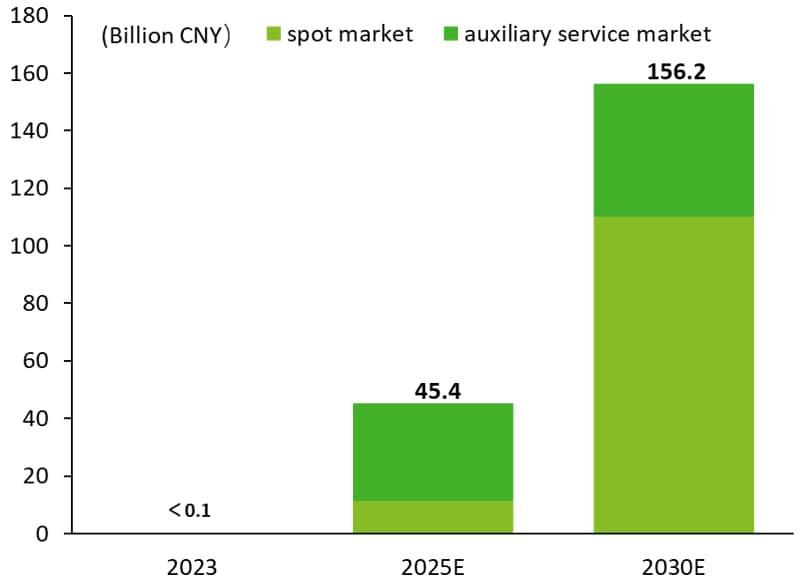
Source: Deloitte China
However, demand for VPP as well as the maturity of the regional electricity market varies across regions and will continue to do so for some time. Analysing some of the established VPPs closely, we found that most such projects are located in the provinces or cities with a well-developed wind and solar power generation capacity but relatively low grid integration. These provinces may also have higher price differentials between peak and off-peak hours. Meanwhile, these regions usually have plans and policies to support VPP or spot market mechanism. Additionally, these regions have a higher penetration of digital and EV technologies, which gives VPPs the tools to aggregate a sufficient amount of distributed energy resources.
Figure: VPP regional market demand and level of maturity
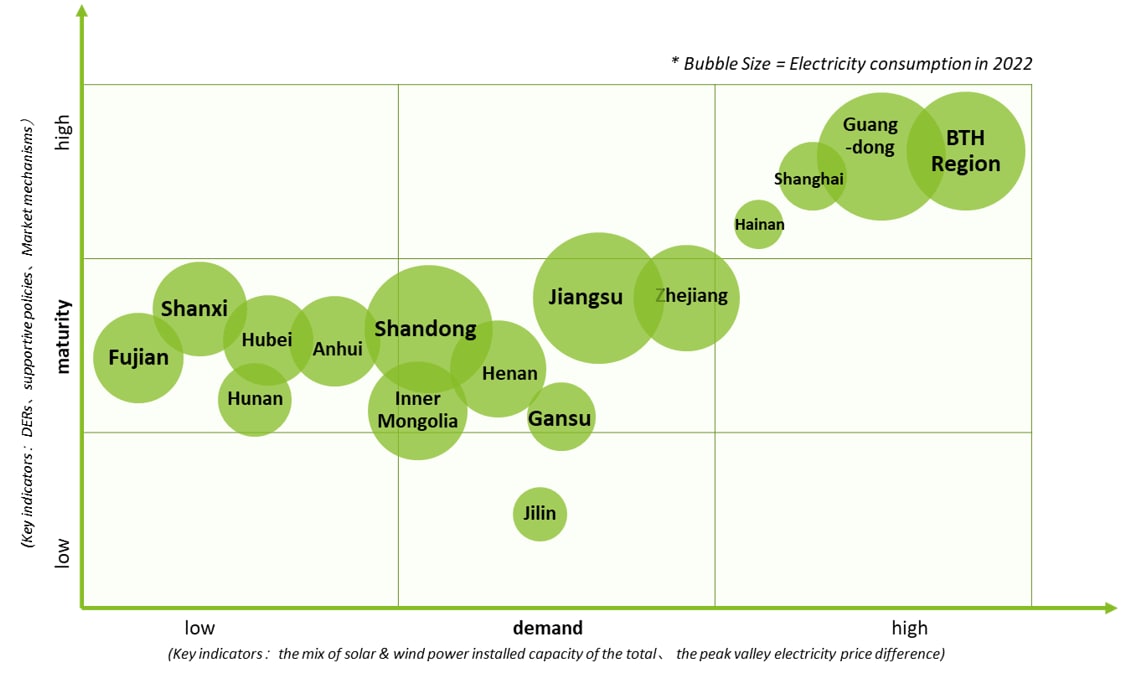 Source: Deloitte China
Source: Deloitte China
Currently, operators of virtual power plants in China are mainly grid companies and power generation enterprises. But, as the VPP business model becomes clearer, companies with expertise in control technology, information communication, and digital technology will also enter the VPP operation market. It's worth noting that at present the interface standards and communication protocols of virtual power plant platforms established by different market entities are not unified, increasing the difficulty of integrating distributed resources. To enhance their capacity to aggregate resources for virtual power plants, stakeholders need to collaborate in addressing the issue of platform interface standardization.
Auto
Blessing or curse: how the unstoppable NEV trend affects China’s automotive aftermarket
As the percentage of new energy vehicles (NEVs) in new car sales continues to grow, the share of NEVs in total car ownership will also rise. As of September 2023, the number of new energy vehicles on the road has reached 18.21 million, accounting for 5.5% of total car ownership in China. It is predicted that China’s share of new energy vehicles in operation will exceed 20% by 2030. By 2045 over 50% of the vehicles in operation (VIO) in China will be new energy vehicles.
How will this change impact the automotive aftermarket? We’ve identified three paradigm shifts that will take place in the automotive aftermarket because of the influx of new energy vehicles.
- Declining parts sales and service revenues: Due to fewer working parts and lower maintenance frequency, electric vehicles generate less revenue through parts sales and after-sales services than gasoline fuelled cars. This is because the internal structure of EVs is much simpler than that of ICEs, with fewer moving parts (as shown in the figure). Since an electric vehicle has no internal combustion, there is no need to replace engine oil and fuel filters. Moreover, EV components are increasingly manufactured in a highly integrated fashion, resulting in less wear and tear and greater longevity. This poses significant challenges to dealers who rely heavily on aftermarket parts sales and services.
- Reduced opportunities for independent workshops: In the gasoline era, carmakers authorize dealers to sell and repair their cars. With more and more NEV makers transitioning to the customer-centric business model, they will try to keep users in their own service ecosystem. To that end, they have adopted an approach that will extend the full life cycle of a customer within the ecosystem by 1/operating aftersales business on their own as maintenance and repair are considered key touch points and 2/adopting an authorized model which sets a strict investment threshold. Such an approach has left little room for independent auto repair workshops as NEV makers and their authorized workshops have secured full control of the distribution of parts, maintenance technology and know-how.
- Changes in skills and capabilities: Differences in vehicle structure also has a profound impact on the need for maintenance equipment, required technologies, types of personnel and corresponding skills. For example, the powertrain of pure electric vehicles is highly integrated and places more emphasis on error diagnosis and detection, requiring professional diagnostic equipment as well as highly skilled, experienced technicians to run them. As NEVs are featuring more and more intelligent functions, such as smart cockpit and autonomous driving, they will rely more and more on remote diagnostic technologies such as big data and cloud platforms. Secondly, intelligent electromechanical products, such as LiDARs, cameras and other sensors, will require professional calibration equipment and experienced technicians to work the systems. Finally, compared with the traditional fuel vehicle mechanics, maintenance technicians are expected to have both auto repair qualifications and electrician certificates, and to master knowledge and skills in high-voltage electricity and electrification.
Changes in the design of electric vehicle products require aftermarket players to rethink their business model, revenue sources and as well as the core capabilities required to maintain competitiveness.
Although the frequency of daily maintenance will decrease, new business opportunities will emerge. For example, the demand for mechanical and electrical repairs and sheet spraying has increased significantly as electric cars are involved in more accidents than their gasoline counterparts mainly due to inappropriate driving behaviours. The latter have already generated higher revenues per car and can to a certain extent offset the negative impact of reduced revenue from maintenance.
In addition, NEV owners are generally younger, more open to new things, and with more money to spend. They are trend driven and enjoy purchasing accessories in order to personalize their NEVs. This has resulted in a surge in the demand for car accessories, personalised modifications, and other such businesses. Finally, the shift from internal combustion to power battery also opens a new source of aftermarket revenue: battery repair, re-use, recycling and remanufacturing.
The rise of NEVs requires a new set of skills and capabilities for aftermarket players as battery-powered cars are controlled mostly through electronics as opposed to gasoline cars which involve more mechanical and engineering knowledge. In NEVs the focus of maintenance is more centred around battery health monitoring, electronic component repair, software OTA and other services. This requires companies to master cloud diagnosis and acquire the machines and personnel needed to to maintain and operate complex electrical systems.
For instance, according to the latest industry protocol on NEV maintenance and repair, new energy vehicle maintenance companies must have dedicated maintenance facilities to match the service items, and should be equipped with fault diagnosis instruments, computer equipment with diagnostic functions, and other battery maintenance equipment and tools. Maintenance technicians should be trained and certified to work. Moreover, technicians engaged in electrical maintenance operations should hold high-voltage or low-voltage electrician operating certificates to qualify for work.
As pointed out earlier, gasoline vehicles will still make up the majority of vehicles in operation -- at least for the next 20 years. But the rise of NEVs cannot be stopped and brings both opportunities and challenges. Any aftermarket players who contemplate tapping into the NEV maintenance market will need to make an informed decision by evaluating the potential market size of new energy vehicles, measuring the economic impact on its business, deciding on their unique positioning and their value proposition in the aftermarket, as well as identifying the investment scale and key capabilities required for the transformation.
Logistics
Logistics firms going public in HK
Since the beginning of this year, several logistics companies have launched plans to list on the HK Stock Exchange. J&T Express submitted an IPO application in June 2023 and was listed on the Main Board of the Hong Kong Stock Exchange on October 27, 2023, marking a solid step towards becoming a global logistics leader. SF Holding and Cainiao also submitted their IPO applications to the HK Stock Exchange in August and September of this year, respectively, and are currently involved in promoting the follow-up process. According to data from Chinaventure, from January to September 2023, a total of 5 logistics companies completed IPOs, of which 2 companies (Seacon and LC Logistics) were listed in HK Stock Exchange. Overall, 5 out of the 8 logistics companies have chosen HK to list.
Figure: Overview of IPOs of Logistics Companies (January – October 2023)
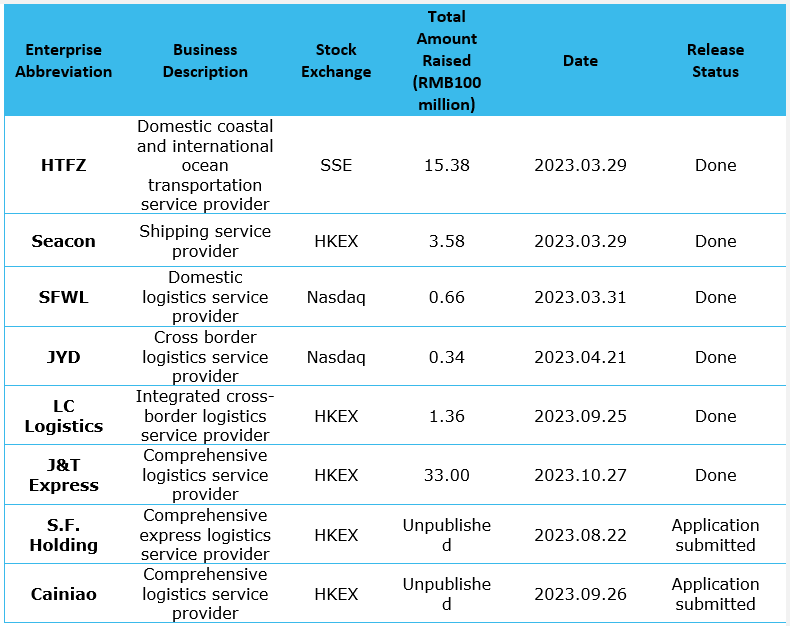
Source: Deloitte China
Key factors driving logistics companies to list on HK Stock Exchange:
Domestic competition: The relaxation of pandemic prevention and control measures has given a boost to the e-commerce industry. At present, market demand for the express delivery industry continues to increase thanks to government efforts to stimulate consumption growth and smooth logistics. According to the National Postal Administration, the volume of express delivery business and revenue will increase by about 16.4% and 11% year-on-year in the first three quarters of this year, far exceeding the same period last year. Faced with the growth of market demand, express delivery companies need to scale up to meet potential market demands. Obtaining the finances through listing is a necessary step in expanding business scale to seize market share. J&T Express, for example, after officially entering the Chinese market in 2020, broke the existing domestic express delivery model with its strategy of ultra-low prices. It quickly entered the first tier of domestic express delivery companies -- but at a price. According to information disclosed in its prospectus, J&T Express lost USD 666 million and USD 6.2 billion in 2020 and 2021, finally making a profit in 2022 – but of USD 1.57 billion only. Although it has turned around from losses to profits, J&T is still under financial pressure and has an urgent need for further financing.
International expansion: With the rapid development of cross-border e-commerce business, China's cross-border express logistics business has great development potential, especially in Southeast Asia and countries along the "the Belt and Road" initiative. From 2016 to 2022, China's import and export CAGR with countries along the "the Belt and Road" reached 14.1%, increasing from RMB 6.25 trillion in 2016 to RMB 13.83 trillion in 2022. From January to July 2023, imports and exports to the "the Belt and Road" countries totalled RMB 8.06 trillion yuan, an increase of 7.4%. However, to enter the international market, enterprises must obtain a large amount of funds to build international brands and international operation teams. Listing can better meet the capital needs of enterprises and help them expand into overseas markets. Take, for example, SF Holdings: through its second listing in HK, SF plans to accelerate its overseas business expansion, create an international brand image, and enhance its competitiveness in the international business arena. If progress goes smoothly, SF will become the first "A+H" (both Shanghai and HK exchanges) listed company in the express delivery industry.
Natural Advantages of HK Stock Exchange: As an international financial center, HK has a developed international capital market and mature financial system. For enterprises hoping to go ‘international’, listing on the HK Stock Exchange is a great springboard. Not only does it allow a company to access international capital, but it gives them greater recognition, helping to consolidate their position in the industry and gain a greater competitive advantage in the international market. In addition, the HK stock market has always been favourable to the express delivery industry, and this helps to attract investors’ and institutions' attention.
Increasingly fierce competition requires continuous innovation and upgrading of enterprises
With increasingly fierce competition among logistics enterprises, technological innovation has become an important driving force in the logistics industry, while improving service quality and expanding business depth has also becomevery important.
Technological innovation can help reduce costs and increase efficiency: By integrating advanced technologies such as artificial intelligence, big data analysis, and the Internet of Things, logistics enterprises can improve efficiency, reduce errors, and achieve more intelligent management. In September of this year, SF Express released its first digital twin practice for large-scale application in the logistics field. Through intelligent algorithms, digital twin practices can verify and optimize logistics routes at extremely low cost and high efficiency, helping to reduce overall logistics costs, avoid capacity waste, and allocate entire link resources more reasonably.
Overall improvement of service quality: Fierce competition on e-commerce platforms has meant that to build customer loyalty and garner greater market share, logistics enterprises must give higher quality and more flexible services, as well as more competitive prices. In May this year, SF Express revealed that its "half-day delivery in the same city" service had expanded to more than 80 cities nationwide. The Cainiao Supply Chain team in Beijing also held a kick-off meeting for the "Half Day Delivery" project, which is expected to cover more than 20 cities nationwide by the end of this year.
Continuous and in-depth expansion of business areas: Logistics enterprises continue to expand their business areas, such as cross-border logistics, cold chain logistics, green logistics etc in order to cope with the constantly changing market environment. Cainiao has deepened its core capabilities in cross-border logistics and fully built out its global end-to-end capabilities, making it one of the four major cross-border logistics companies in the world. SF Express, together with Shenzhen Metro, has started building the first air-rail intermodal green rail logistics network in Shenzhen, helping to promote low-carbon, green logistics.
Consumer
Outlets and travel underpin a moderate consumer recovery
National Bureau of Statistics released the latest consumption data, showing a year-on-year increase of 5.5% in the total retail sales of consumer goods in September. This is the second time since August that the y-o-y growth of retail sales of consumer goods has exceeded the previous month. Meanwhile, according to the State Taxation Administration, the daily sales of the domestic wholesale and retail industry increased by 14.1% year-on-year during the National Day holidays this year. If, in Q4, consumption continues to grow at the same pace, it is likely that the second wave of retail recovery post August, will become a lasting one. When one looks at the sub sectors, we see that essentials such as tobacco, alcohol, food, and beverages continued to maintain a high growth trend in September while optional categories such as apparel and footwear, gold and jewellery, see high single-digit growth. However, household appliances and building materials kept declining due to the cooling off of the real estate boom.
Figure: China’s consumption data by category
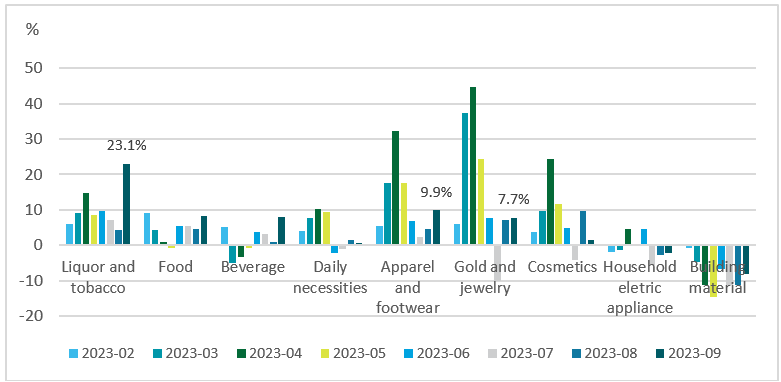
Data source: National Bureau of Statistics
Overall, insufficient consumer confidence remains the key factor affecting the recovery of retail. According to the National Bureau of Statistics, as of the end of August, the consumer confidence index was 86.5, below the strength baseline for the 18th consecutive month. To boost consumer confidence, the central government has not only continuously released policies and measures to promote consumption, but also recently issued the "Notice on Raising the Special Additional Deduction Standards for Personal Income Tax" and the "Notice on Reducing the Interest Rate of Existing First Home Loans". Focusing on tax and loan exemptions, the government has reduced residents' living costs and made consumers more willing to consume.
Despite the many challenges facing retail in the post pandemic environment, we do see some exciting new opportunities:
The rise of the discount model of consumption.
Consumer preferences continue to change after the pandemic. The most intuitive and significant change lies in the increasingly cautious and rational approach to consumption being adopted by domestic consumers, as well as the emphasis on cost-effectiveness. It is worth mentioning that consumers' pursuit of quality has not weakened, and compared to the pre-pandemic period, they are more eager to purchase products that combine quality and cost-effectiveness. This is why the outlet model suits the post-pandemic consumer so well. Previously, outlets were a channel for handling overstocks or closeout goods. Now they have become indispensable as a customer acquisition channel for retail enterprises.
Recently, we have seen a rapid rebound in the performance of discount e-commerce represented by traditional outlets and Vipshops. In addition, the discount model is also being extended to other traditional formats. Firstly, supermarket giant Yonghui announced the establishment of a "genuine discount store" and the simultaneous addition of a discount zone in online apps/mini programs, aiming to enrich product categories and provide consumers with more cost-effective choices while accelerating the efficiency of product elimination and renewal. Meanwhile, in response to the requirements of the post-pandemic consumer, Hema Fresh has recently started lowering the prices of 5000 standard products in its offline stores. Greater cost effectiveness will be brought about by streamlining SKUs, private-label brands, high-quality and low-cost product operations, and building vertical supply chains that can reduce costs. Faced with sluggish growth and increasingly fierce competition, enterprises need to deepen their understanding of the new consumer mindset. Increasing market share in the post pandemic environment will only be possible through differentiated products, targeted marketing, and supply chain innovation.
Stimulus targeting the tourism industry.
Against the backdrop of the initial rebound in domestic service consumption, the General Office of the State Council issued a notice in September entitled "Measures to Unleash the Potential Of Tourism Consumption and Promote High-quality Development Of Tourism Industry". The policy aims to increase the supply of high-quality tourism products and services, boost demand, and improve inbound tourism services. On the one hand, the policy touched upon ways to further increase tourism through the integration of the culture, sports, business, and tourism sectors in various regions of China. More specifically, during peak consumption periods like summer and winter vacations, support will be given for the creation of programs and activities targeting families such as amusement parks, performances, museums, sports, exploring coastal areas, forests, grasslands etc will be launched for example. Retail, as a key component of the tourism industry in terms of food, hotel, transportation, travel, shopping, and entertainment, will benefit from the growth of the tourist trade. In addition, easing the requirements for visas, restoring and increasing international flights, and optimizing departure tax refund services will further benefit duty-free retail businesses such as duty-free stores and entry-exit duty-free stores in the city.

